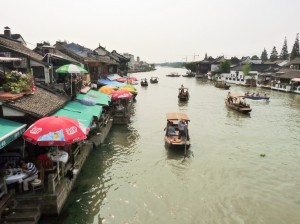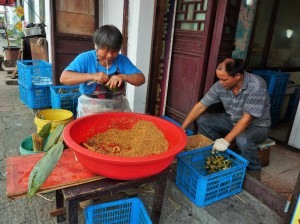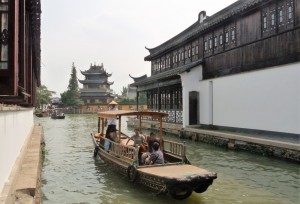-
A HIDDEN BEAUTY SPOT
In contrast to the city of Beijing, wherein we visited some of the most splendid sites of Chinese historical significance, Shanghai seemed bound to impress us with its ultra modern, cosmopolitan character and its new high rises. Even though we were informed that a number of old structures in Shanghai were being preserved in order to conserve the roots of this area, our initial general impression was that the new buildings had taken over considerably its Chinese origins.
 Therefore, it was quite a pleasant surprise to learn that tucked safely away at relatively short distances from this avant-garde city, one could still find a wide selection of ancient water towns which offer the opportunity to relish the charm of an ancient China. Known as the ‘Little Venices of the East’, these unique towns of exceptional allure are a wonder of cultural landscape. A visit to at least one of them, is definitely a must once you are in Shanghai.
Therefore, it was quite a pleasant surprise to learn that tucked safely away at relatively short distances from this avant-garde city, one could still find a wide selection of ancient water towns which offer the opportunity to relish the charm of an ancient China. Known as the ‘Little Venices of the East’, these unique towns of exceptional allure are a wonder of cultural landscape. A visit to at least one of them, is definitely a must once you are in Shanghai.Since we had only one day left in Shanghai, our guide led us to Zhujiajiao which is located only forty seven kilometers away from this city, in the district of Qingpu. With a history of around 1700 years, Zhujiajiao is renowned as one of the best preserved ancient water towns of the area. Like much of the other sites in China, once we got there, we found the place pretty crowded, especially since on that day, the local people were celebrating the Mid-Autumn Festival. Indeed, during public holidays, these water towns are very popular with Shanghai residents who yearn for moments of tranquility, away from the hustle and bustle of the urban areas.
 The settlement of Zhujiajiao dates back to the Yuan dynasty, when this location was turned into an important trading hub for the surrounding countryside. Since it is strategically situated at the intersection of a number of local rivers, Zhujiajiao continued to gain significance, and during the reign of Emperor Wanli of the Ming dynasty, it was granted township status. The town prospered by trading rice and cloth which were transported on boats from the surrounding countryside, right to the houses of the Zhujiajiao merchants.
The settlement of Zhujiajiao dates back to the Yuan dynasty, when this location was turned into an important trading hub for the surrounding countryside. Since it is strategically situated at the intersection of a number of local rivers, Zhujiajiao continued to gain significance, and during the reign of Emperor Wanli of the Ming dynasty, it was granted township status. The town prospered by trading rice and cloth which were transported on boats from the surrounding countryside, right to the houses of the Zhujiajiao merchants.Today, this town which covers about 3 square kilometers, has a population of about 70,000 people. Although nowadays, one finds some recent and modern structures in Zhujiajiao, about a thousand of the surviving buildings and ancient markets were constructed during the Ming and Qing dynasties.
 Thirty six bridges of different sizes, designs, and materials, cross the small rivers shaded by willow trees, and connect the ancient town. Whilst the narrowest bridges are only about a metre wide, Zhujiajiao can boast to have the largest stone arch bridge in Shanghai. Originally built in 1571 by the monk Xingchao of Cimen Temple in 1571, and then rebuilt in 1812, Fangsheng Bridge rests on five arches and is 70 metres long, and 5.8 metres high. The central arch is decorated with a stone relief of eight dragons surrounding a pearl, whilst the pillars at the ends are sculpted into lions.
Thirty six bridges of different sizes, designs, and materials, cross the small rivers shaded by willow trees, and connect the ancient town. Whilst the narrowest bridges are only about a metre wide, Zhujiajiao can boast to have the largest stone arch bridge in Shanghai. Originally built in 1571 by the monk Xingchao of Cimen Temple in 1571, and then rebuilt in 1812, Fangsheng Bridge rests on five arches and is 70 metres long, and 5.8 metres high. The central arch is decorated with a stone relief of eight dragons surrounding a pearl, whilst the pillars at the ends are sculpted into lions.Interestingly, ancient bridges can be recognized from more recent ones by looking at the height of their stairs, since in the old days, these were quite steep, whereas nowadays, steps are constructed in lower and more uniform positions, in order to be more easily accessible, especially to the elderly.
 Both these bridges and the town itself can be appreciated further by taking a cruise on one of the small bamboo gondolas that navigate the countless waterways of Zhujiajiao. A short trip and a longer one are offered, wherein the first takes passengers up and down the main canal, whilst the latter travels all over the town and back.
Both these bridges and the town itself can be appreciated further by taking a cruise on one of the small bamboo gondolas that navigate the countless waterways of Zhujiajiao. A short trip and a longer one are offered, wherein the first takes passengers up and down the main canal, whilst the latter travels all over the town and back.In order to explore this town, one needs about four hours. Narrow streets filled with different shops that sell typical souvenirs and various other products are often packed with tourists who tend to disrupt the serenity that one would have expected to find in such a location. The one kilometre North Streetis the best preserved ancient street in this suburb where one can observe the historical architecture. On the other hand, in Xijin Street, one can visit the classical Kezhi Garden with its distinguished combination of traditional Chinese and Western styles.
 A closer investigation of Zhujiajiao can offer much more to see, includingTongtianhe Medicine Shop, Qing Dynasty Post Office, Baoguo Temple, and Yuanjin Meditation Room. A selection of bars, restaurants, teahouses, and coffee shops provide the opportunity to rest and to taste some local cuisine whilst gazing out at the rivers or the main canal.
A closer investigation of Zhujiajiao can offer much more to see, includingTongtianhe Medicine Shop, Qing Dynasty Post Office, Baoguo Temple, and Yuanjin Meditation Room. A selection of bars, restaurants, teahouses, and coffee shops provide the opportunity to rest and to taste some local cuisine whilst gazing out at the rivers or the main canal.Having gone through a period of inactivity, where life crawled on at a slow pace, in these last years Zhujiajiao has gone through a rapid transformation as both locals and foreigners began to long for such preserved gems which can relate strongly to a bygone period in China.
Although some believe that the heavily touristic element on which the inhabitants have become highly dependent, is ruining the romantic nature of this sublime ancient water town, I can say that I enjoyed every minute which I spent in this exotic place. A heaven for photographers, Zhujiajiao provides an unforgettable experience of a surreal Chinese life which has succeeded to endure the test of time.
(This article was published in ESCAPE Suppliment which was issued with the Sunday Times of Malta dated 1st November 2015)
Category: The Sunday Times - Articles | Tags: and Yuanjin Meditation Room,Baoguo Temple,Beijing,Chinese,Emperor Wanli,Kezhi Garden,Little Venices of the East,Mid-Autumn Festival,Ming Dynasty,North Street,Qing Dynasty Post Office,Shanghai,Tongtianhe Medicine Shop,Xijin Street,Xingchao of Cimen Temple,Yuan dynasty,Zhujiajiao